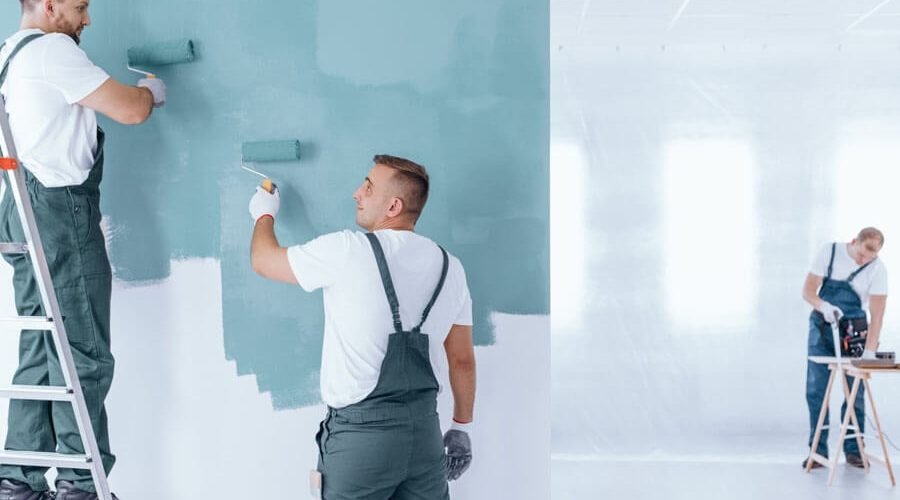When it comes to painting your business, there are a lot of factors to consider. You need to make sure that you’re selecting the right paint and primer for the surface, that you have the correct tools and supplies, and that you understand the painting process. We’ll outline 10 things you need to know about commercial painting services. We’ll also provide tips on how to select a contractor and how to prepare your business for professional painting services. Read on to learn more!
Table of Contents
Check The Types Of Commercial Painting
There are different types of professional commercial painting services, so you’ll need to select the one that’s right for your business. If you’re not sure which service to choose, ask a contractor for their recommendation. Some businesses require specialized exterior painting services, such as anti-graffiti coatings or lead paint removal. Make sure to discuss your needs with commercial painters during normal business hours before booking services. The types of commercial painting available are:
Indoor Painting
This type of commercial painting service is ideal for commercial property owners that want to refresh their space or change the look of its interior. Interior painting can be used to update your color scheme, add accents, or simply give your business a new look.
Outdoor Painting
This type of commercial painting service is perfect for businesses that want to improve their curb appeal or protect their building from the elements. Exterior painting can be used to update your color scheme, add accents, or repair damaged areas of your commercial building.
Specialized Painting
This type of commercial or residential painting service is perfect for businesses that require specific types of coatings, such as anti-graffiti or lead paint removal. Specialized painting services can be used to protect your business from unique threats or improve its appearance.
Consider The Surface Of Your Business
When you’re selecting commercial painting projects, it’s important to consider the surface that will be painted. Different surfaces require different types of paint and primer, so it’s important to speak with a contractor about your options. The most common types of surfaces that are painted are:
Drywall Surface
Drywall is a type of wallboard that’s used in the construction of walls and ceilings. It’s made from gypsum, paper, and fiber, and it’s one of the most common types of surfaces that are painted.
Metal
If you’re looking to have metal surfaces painted, it’s important to select the right paint and primer. Metal surfaces can be tricky to paint, so it’s important to speak with a contractor about your options. The most common types of metal surfaces that are painted are:
Steel Or Aluminum Siding
Aluminum siding or steel siding can be painted with a variety of different paint types. The most common type of paint used on steel siding is acrylic enamel. This type of paint provides a durable, long-lasting finish. For aluminum siding, the most common type of paint used is epoxy-based paint. This type of paint provides a durable, long.
Wood
Wood surfaces can be painted with a variety of different paint types. The most common type of paint used on wood is latex-based paint. This type of paint provides a durable, long-lasting finish.
Wood surfaces, such as trim or cabinets, can be painted to update their look or to protect them from damage.
Concrete
Concrete surfaces, such as floors or walls, can be painted to change their appearance or to protect them from damage. The most common type of paint used on concrete is latex-based paint. This type of paint provides a durable, long-lasting finish.
Prepare The Surface
The first step in preparing the surface is to clean it. This involves removing any dirt, dust, or debris that’s on the surface. You can use a vacuum, broom, or dust cloth to remove debris.
If the surface has old paint or wallpaper, you’ll need to remove it. This can be done with a variety of different tools, including a paint scraper, putty knife, or steamer.
Once the surface is clean and free of old paint or wallpaper, you can begin repairing any damage. This might involve filling holes with spackles, sanding down rough areas, or priming the surface.
Once the surface is prepared, you can begin painting.
Prepare Your Business
If you’re planning on painting your business, there are a few things you’ll need to do to prepare. This includes protecting your furniture and flooring, removing wall hangings, and covering electrical outlets.
You’ll also need to remove any items from the room that you don’t want to get paint on. This might include computers, printers, and file cabinets. Once the room is empty, you can begin painting.
It’s important to choose the right paint for your project. This might involve selecting a specific type of paint or choosing a color that’s compatible with your business.
You’ll also need to select the right primer and paint brushes. Be sure to discuss these items with your contractor.
Choose The Right Paint And Primer
When selecting paint and primer, it’s important to consider the type of surface you’re painting, the environment, and your budget. There are a variety of paint types available, so you’ll need to select the one that’s right for your project. For example, latex paint is a good choice for most surfaces, but oil-based paint is better for high-traffic areas. You’ll also need to select a primer that’s compatible with your paint type.
In most cases, you’ll need to apply two coats of paint. The first coat is called the primer coat and it’s used to prepare the surface for painting. The second coat is called the finish coat and it’s used to achieve the desired color and finish.
It’s important to allow each coat of paint to dry completely before applying the next one. Depending on the type of paint and primer you’re using, this can take anywhere from a few hours to a few days.
Get The Right Tools And Supplies
To complete your project, you’ll need to have the right tools and supplies on hand. This includes paintbrushes, rollers, drop cloths, ladders, and other painting supplies. You can purchase these items at your local hardware store or online.
When painting, it’s important to wear the proper clothing. This includes long pants, a long-sleeved shirt, and closed-toe shoes. You’ll also need to protect your eyes and lungs from fumes by wearing goggles and a mask.
Understand The Painting Process
Before beginning your project, it’s important to understand the painting process. This includes learning how to mix paint, how to apply primer and paint, and how to clean up afterward. By following these steps, you can ensure a successful painting project.
Before beginning your project, you’ll need to mix the paint. This can be done by pouring the paint into a container and stirring it with a stick. Once the paint is mixed, you can begin painting.
Select A Contractor
If you’re not comfortable painting your home yourself, you can hire a professional painter from a commercial painting company to do it for you. When selecting a contractor, it’s important to get multiple estimates and to select a contractor that’s licensed and insured.
When selecting a contractor, it’s important to choose someone with experience in commercial painting. You can ask for referrals from friends or family, or you can search online for reviews. Once you’ve selected a contractor, be sure to discuss your project in detail and get a written estimate.
How Long The Painting Process Will Take
The painting process can take anywhere from a few days to a few weeks, depending on the size of your project. In most cases, it’s best to plan for at least a week of painting. This will give you time to complete the project without feeling rushed.
When you’re planning your project, be sure to allow for drying time between coats of paint. Depending on the type of paint you’re using, this can take anywhere from a few hours to a few days.
Tips For Maintaining Your Newly Painted Surface
Once your project is complete, there are a few things you can do to maintain your newly painted surface.
- Be sure to clean any dirt or debris off of your surface regularly. This will help to prevent the paint from chipping or peeling.
- In addition, be sure to repair any cracks or holes in your surface as soon as possible. This will help to prevent further damage to your paint job.
- Finally, be sure to keep an eye on the weather. If it’s going to be particularly hot or cold, it’s best to wait to paint.
By following these tips, you can ensure that your newly painted surface will last for years to come.
Final Words
Commercial painting is a big job, but by following these tips, you can ensure a successful project. Be sure to discuss your needs with a contractor, choose the right paint and primer, and prepare your business before painting. With these tips in mind, you can rest assured that your commercial painting project will be a success!





